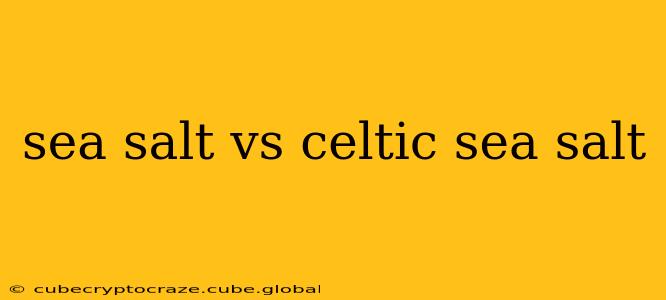Sea salt. The very words conjure images of sun-drenched coasts and the pristine ocean. But within the world of sea salt, subtle yet significant differences exist. This article delves into the comparison between regular sea salt and Celtic sea salt, exploring their origins, mineral content, taste, and potential health benefits. We'll also tackle some frequently asked questions to provide a comprehensive understanding of these popular culinary choices.
What is Sea Salt?
Sea salt, in its simplest form, is salt harvested from the ocean. The process involves evaporating seawater, leaving behind salt crystals. The resulting product can vary considerably depending on the location of harvesting, the method used, and the level of processing. Some sea salts are minimally processed, retaining more of their natural minerals, while others undergo further refinement. This variability directly impacts the final product's taste, texture, and mineral profile.
What is Celtic Sea Salt?
Celtic sea salt, often hailed as a premium variety, originates primarily from the Guérande salt marshes in Brittany, France. These marshes employ traditional methods of salt production, utilizing the natural evaporation of seawater in shallow basins. Unlike many commercially produced sea salts, Celtic sea salt undergoes minimal processing, preserving a higher concentration of trace minerals. This contributes to its distinct grayish color and slightly complex flavor.
What are the Key Differences Between Sea Salt and Celtic Sea Salt?
The primary differences lie in the mineral content, processing, and flavor.
-
Mineral Content: Celtic sea salt boasts a richer mineral profile than many other sea salts. It contains higher levels of essential minerals like magnesium, potassium, and calcium, contributing to its purported health benefits. While all sea salts contain trace minerals, the concentration varies significantly.
-
Processing: Celtic sea salt's production adheres to traditional, often hand-harvested, methods, minimizing processing and preserving its natural mineral composition. Many commercial sea salts undergo more extensive refining and bleaching, potentially removing some beneficial trace minerals.
-
Flavor: Celtic sea salt possesses a more complex, nuanced flavor compared to many commercially processed sea salts. Its subtle mineral notes add depth and richness to dishes.
-
Color & Texture: The unrefined nature of Celtic sea salt gives it a characteristic grayish color and a slightly coarser texture compared to the finer, often whiter texture of many commercially produced sea salts.
Is Celtic Sea Salt Healthier Than Regular Sea Salt?
While both contain sodium, Celtic sea salt's higher mineral content is often cited as a potential health advantage. These trace minerals play various roles in bodily functions. However, it’s crucial to note that this does not imply Celtic sea salt is a "health food" that can replace essential mineral supplements or a balanced diet. The sodium content in both remains a consideration for individuals monitoring their sodium intake. More research is needed to fully understand the long-term health implications of different types of sea salt.
Does Celtic Sea Salt Taste Different?
Yes, definitively. Celtic sea salt offers a more complex and nuanced flavor profile than many refined sea salts. Its slightly bitter, earthy notes, stemming from its higher mineral content, complement many dishes, adding depth and a distinctive taste. Many find its flavor more appealing and less intensely salty than commercially refined sea salt.
Which is Better for Cooking?
The "better" salt depends on your preference and the dish. For delicate dishes where subtle flavors are crucial, Celtic sea salt's complexity can enhance the overall experience. For everyday cooking, regular sea salt works just as well. Experiment to determine your preference.
How Much Sodium is in Celtic Sea Salt?
Like all sea salts, Celtic sea salt contains sodium. While the exact amount can vary, it remains a significant component. Individuals monitoring their sodium intake should consult dietary guidelines and adjust their consumption accordingly.
What are the Benefits of Using Celtic Sea Salt?
Proponents of Celtic sea salt highlight its higher mineral content as a potential health benefit. These minerals may contribute to various bodily functions. However, it's vital to remember that more robust scientific research is needed to fully validate these claims. The primary benefit for many is its enhanced taste and texture compared to highly refined sea salts.
In conclusion, while both sea salt and Celtic sea salt are natural options, Celtic sea salt stands out due to its traditional production methods, higher mineral concentration, and complex flavor profile. The choice ultimately depends on individual taste preferences and culinary needs. Always remember to consume salt in moderation as part of a balanced diet.
